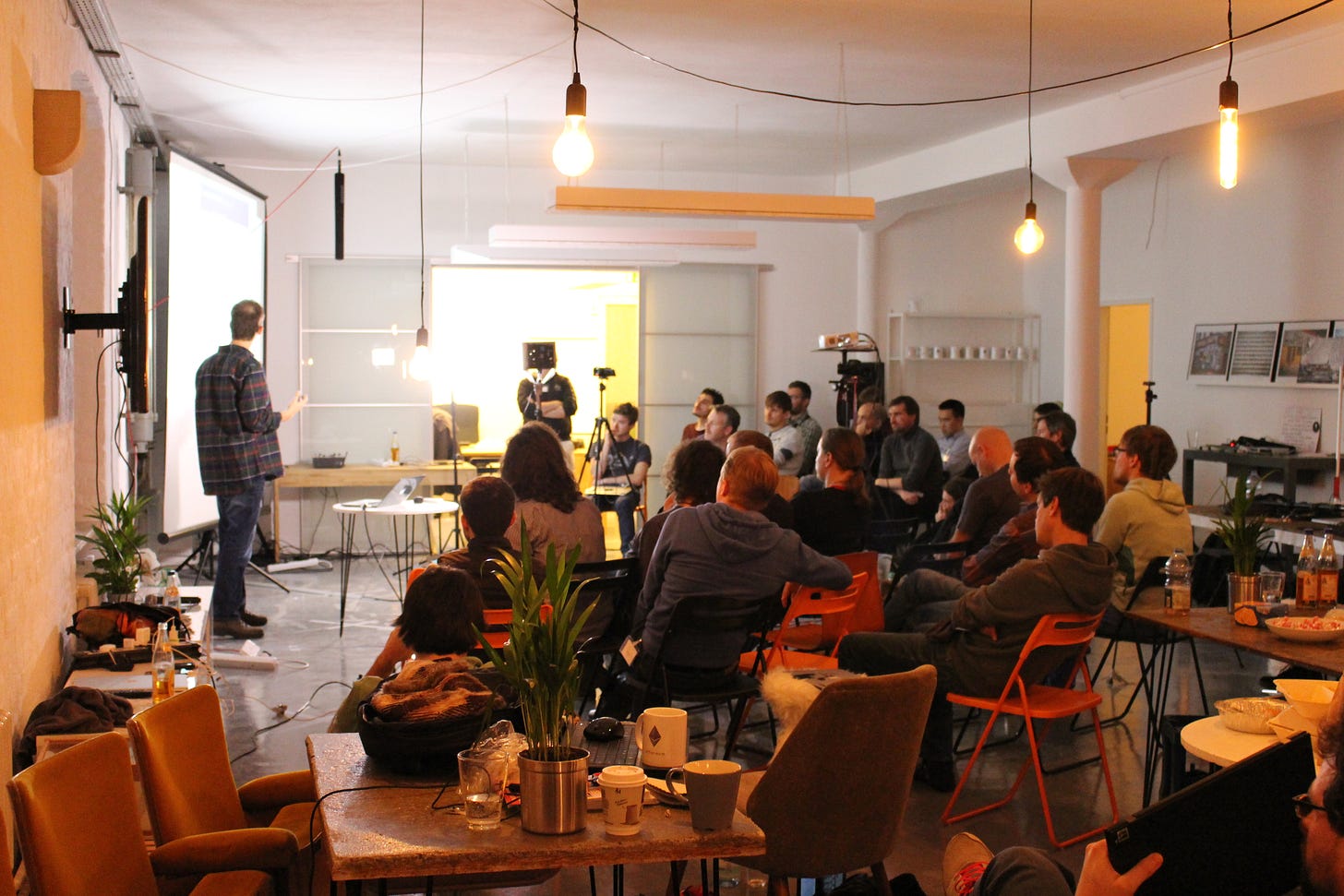Devcon Days 3 & 4: DeFi Composability, Scam Controversy, Metamask Plugins
Happy Friday defiers! After four days of technical and philosophical talks, company announcements, hacker workshops, but mostly, tons of hanging out with old and new friends on the sidelines, Devcon5 drew to a close in Osaka.
The progress that Ethereum has made in six years since the first Devcon in Berlin, where everyone fit in a single room and speakers didn’t need microphones to deliver presentations about a platform that hadn’t launched yet, is remarkable. This year more than 3,000 people filled about 16 different rooms in a stadium-sized convention center with views to Osaka bay, catered Japanese food, and a drums performance, on top of the rainbow colors and cute animals –on onesies, cardboard cut-outs, slideshows, and even real-life ones– which are the usual at Ethereum gatherings.

Devcon0. Image source: Ethereum.org

Devcon5. Image source: Me :)
The focus of this year’s Ethereum developer conference was on the transition to Ethereum 2.0 and on improving user and developer experience on the current chain. I covered Day 1 and Day 2. Here are the highlights from Days 3 & 4:
Eth2 Mostly Preserves DeFi Composability, Vitalik Says
The transition to Ethereum 2.0 should be smooth for users and developers, and decentralized finance applications will be able to keep “talking” to each other, Ethereum creator Vitalik Buterin wrote in two research posts published during Devcon.
DeFi Composability Report
Things to understand: Ethereum 2.0 is a new, upgraded Ethereum chain. It will have a proof-of-stake consensus algorithm and a scaling solution called “sharding,” which as the name suggests, divides the chain into many pieces to increase the number of transactions per second. In this new architecture, projects will exist in different shards. To some developers, this raises the risk that communication between projects will be difficult.
Decentralized finance relies on the ability of projects to connect with and build on other projects. Just the very basic action of trading ERC20 token, already requires composability. So the question is, will DeFi continue working seamlessly in Eth2? Vitalik says “largely,” yes.
Transactions between shards can still happen quickly, but they would be "asynchronous,” meaning, not within a single transaction. Developers would have to pull the contracts into a single shard and perform the operation synchronously there. Still, most use cases would not be significantly disrupted or could be trivially rewritten to survive in a cross-sharded model, Vitalik says, listing examples including from Uniswap, Compound, and Set Protocol.
Eth2 Transition Report
Disruptions to users and developers in the transition to Ethereum 2.0 from the current chain “will actually be quite limited,” Vitalik wrote. Existing applications will keep running, while account balances, and contract code and storage will carry over.
The planned transition will happen as follows:
After phases 0 to 2 have been implemented and the Eth2 chain is stably running, the full state (root) of Eth1 will be fed into Eth2. Users will have to download code that implements the network upgrade, which will be the same as any other upgrade, except they will need to include an Eth2 client. The chain will likely halt for about one hour, after which it will look like Ethereum is back online, “except at that point eth1 would be functioning as a subsystem inside eth2 instead of being a standalone system,” Vitalik wrote.
The biggest disruption will be that gas costs for some functions will increase, but developers “can eliminate the largest part of disruption from gas cost changes” by proactively taking specific measures in their code.
“Ethereum Scam”
It’s a common narrative, especially among Bitcoin advocates, to say that Ethereum is a scam…

Metamask Launches Web3 Plugins
Digital wallet Metamask is launchingplugins to add crypto-based functionality to normal websites.
Metamask, which is a browser extension, will provide scripta loaded over verified permissionless protocols (like ENS, IPFS, or Swarm), to create a personalized wallet experience.
Every plugin has the ability to provide its own API to the sites that a user visits, as well as to other plugins, allowing plugins to build on each other, in a sort of decentralized dependency graph.
A Glimpse into Private Identity
Self-sovereign identity project Iden3 and decentralized exchange DeversiFi partnered to create a game for Devcon attendees, with the purpose to test technology that would enable people to be in control of their personal data.
DeversiFi issued a constant stream of its Nectar tokens. Players who get invited into the game, create an identity and get a portion of those tokens. Mutual connections can cooperate or betray each other, generating a prisoner’s dilema.
At the end of the game, users will receive a claim from the application server confirming their digital identity and their performance. They can then use this claim to receive the Nectar tokens they’re due, without revealing their identity. This is done by generating a zero-knowledge proof (zkSNARK). That means they’re able to prove only the information that’s necessary for them to get their tokens, and nothing else.
For most Devcon attendees (including myself) this was probably the first time ever interacting with this technology.
Sign up to get the best and only daily newsletter focusing on decentralized finance news, complete with analysis, exclusive interviews, scoops, and a weekly recap. Those who become paying subscribers in the current 60-day beta period which started Oct. 1 get early supporter discount :)
About the author: I’m Camila Russo, a financial journalist writing a book on Ethereum with Harper Collins. I was previously at Bloomberg News in New York, Madrid and Buenos Aires covering markets. I’ve extensively covered crypto and finance, and now I’m diving into DeFi, the intersection of the two.


